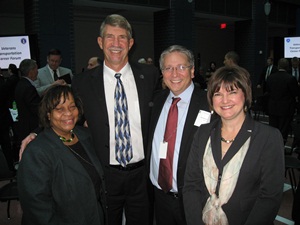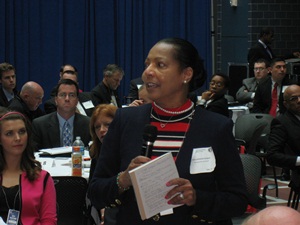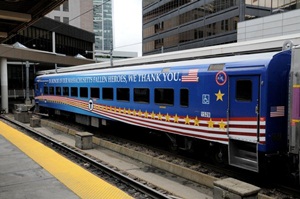|
Veterans and the public transportation industry seem to be a perfect fit in a number of ways, but some formidable obstacles stand in the way of bringing these entities together.
The consensus that arose from three hours of discussion at an Oct. 18 forum, “Veterans Transportation Career Opportunities,” is that all partners must attempt to do everything they can to make the transition of soldiers from the military to the civilian workforce as seamless as possible.
DOT and the Department of Labor jointly convened the forum, which attracted a diverse group of almost 200 participants including APTA members; local, regional, and national transportation officials; federal employees and military personnel; representatives of civic organizations; unions; and members of the private sector.
In his opening remarks, DOT Secretary Ray LaHood called U.S. soldiers “a generation of heroes who have risked their lives all over the world. Giving opportunities to talented and skilled veterans is the least that we can do … We want to engage all of you. We’re not doing this just because it’s the right thing to do. They have practical and on-the-ground experience that we need. There are no more better skilled workers—men or women—than veterans.”
During the event, the group members considered the successes and myriad trials they face in linking skilled veterans with decent, well-paying jobs and careers both challenging and productive.
Dick Ruddell, president/executive director, Fort Worth Transportation Authority (The T), Fort Worth, TX, and a Vietnam veteran, presented the efforts of public transit agencies around the country as an example of how to successfully hire qualified veterans. He said the public transportation agencies represented by APTA employ between 20,000-30,000 veterans, adding: “APTA is doing a great job spreading the word.”
Toward the end of the panel discussion, Ruddell unfurled a scroll-like banner with the names and divisions of veterans employed by The T. He also discussed activities by APTA to honor veterans this year and encouraged fellow public transit officials to develop inventive ways to pay tribute to those who have served this country.
He exhorted the audience not to waver in their commitment to veterans, regardless of the challenges, and asked forum participants to continue building on the tradition of hiring veterans.
“When I came out of the service in 1972, I knew nothing about transit,” said Ruddell. “Those were tough economic times with unemployment, but somehow the U.S. found a way to meet veterans’ needs. We need to find ways to employ vets. Transportation is a great way to do this.”
Alice Tolbert-Wiggins, director, project development, with Parsons Brinckerhoff in Atlanta, a past member-at-large of the APTA Executive Committee, promised to use APTA “to spread the gospel.” She said she plans to contact corporations and Department of Defense (DOD) officials and create a task force to share information and collaborate efforts.
Problem and Solutions a World Apart
Practical issues—such as integrating injured veterans into the workforce; dealing with post-traumatic stress disorder (PTSD); and disparities in employment requirements, training, and civilian certifications for trucking and commercial drivers’ licenses (CDL)—translate into a wide gap that must be bridged, forum participants noted.
Kristen Joyner, executive director of the South West Transit Association, said public transportation systems need veterans and spoke of her association’s efforts to match veterans with private industry and public transportation providers. She asked panelist Frank C. DiGiovanni, DOD director of training readiness and strategy, if service personnel would be eligible for weekend part-time driver positions being made available by Sun Metro in El Paso, TX. He said individual installation commanders can make that decision.
Deputy Secretary of Labor Seth Harris, who represented Secretary Hilda Solis, said simplicity is the key. “We all learned in grade school that the shortest distance between two points is a straight line. That’s the philosophy we need to apply here,” he said. “The shortest distance from a military career to civilian jobs is a job that resembles a military job, such as pilots and sailors, who can easily transition.”
But this process may be much more difficult in other occupations, Harris acknowledged. “We have to work out the problems that they have between civilian certification and licensing [and the military],” he said. “This is so important because so many of these careers are in transportation.”
Harris explained that 2,600 American Job Employment Centers provide veterans with assistance including placement, counseling and job services. These centers served 1.6 million veterans last year, 500,000 of whom went directly into jobs. Further, 87,000 veterans received what he called special “Gold Card” services, which include career options found online, one-stop employment services and placement assistance, job skills, and related assistance.
The Conundrum of Licenses, Certification, and Testing
Anne S. Ferro, administrator of the Federal Motor Carrier Safety Administration, lauded audience members “who have been working on this for many years.” She said increasing “progress has been made the last couple of years in removing barriers.”
One fundamental obstacle Ferro cited centers around veterans securing CDLs. The crux of the problem has been twofold: Soldiers must prove they have at least three years’ experience, because without that experience they will not be hired or insured; and other barriers confronting military personnel must be lowered, allowing them to secure these licenses without jeopardizing overall safety.
Several panelists reported on new rules, laws, and initiatives that help to erode those barriers. For example, a final rule released in May gives states the leeway to accept prior experience and documentation that would allow military drivers to take a written test and forego a skills test if they have two years’ experience. To date, 39 states have adopted this waiver.
In addition, the domicile requirement has been removed, so a soldier who lives in South Dakota, for example, would be considered a Virginia resident if he or she is stationed at Quantico.
Ferro said the recently passed transportation authorization bill, Moving Ahead for Progress in the 21st Century, includes provisions affecting veterans and CDLs, further identifying gaps that prevent or challenge movement across careers.
Attendees at each table received two topics on the issue to discuss. Military and civilian participants soon engaged in detailed conversation about waivers; transition assistance programs; credentialing; automatic versus standard transmissions; gaps in Class A, B, and C across the civilian-military divide; and a host of other issues.
Collaboration and Partnerships Bridging the Divide
Jane Oates, DOL assistant secretary of employment and training administration, praised the collaborations between the departments, across a number of states, particularly people’s willingness to roll up their sleeves and prioritize securing jobs for veterans.
“There are two customers: Job seekers and employers. It’s deeply disturbing to hear employers say that they can’t find veterans,” she said.
Oates, who served for nearly a decade as senior policy advisor for the late Sen. Edward M. Kennedy (D-MA), encouraged participants not to hesitate if things aren’t clear enough or if the Department of Labor isn’t being a good partner.
“The Department of Transportation is absolutely aggressive in seeking partnership with the Department of Defense,” said DiGiovanni. “Things are happening … paradigms are changing. We have pilots who walked across the street to become commercial pilots. There’s something to this initiative.”
Panelist Ross Cohen agreed. “I don’t think by any means that we need to take our feet off the pedal,” said Cohen, who served in the U.S. Army for three years and is now senior director of programs and operations for the U.S. Chamber of Commerce’s Hiring Our Heroes program. “This has been an unprecedented public-private partnership and we are seeing unemployment beginning to decline. The key to collaboration has been solved over the last four years. It’s very exciting, very encouraging.”
After speaking with veterans suffering from PSTD, DiGiovanni said he gleaned three common themes: leadership; teamwork; and decision making (adaptability and critical thinking). “When you look at industry, they’re ahead,” he said. “They operate in highly dynamic, complex environments, and this makes vets stand out from the ordinary.”
DiGiovanni said 300,000 military personnel leave the service each year and currently DOD spends $950 million on unemployment compensation for veterans—an incentive for the federal government and its partners to direct these vets into jobs and lessen that burden. He cited a recent National Defense Authorization Act study that identifies five career fields offering the best opportunities for ex-military to get jobs and get credentialed: transportation; airframe and power plants; logistics; automobile mechanics; and healthcare, referring to veterans such as corpsmen and medics.
Panelists, who included veterans and federal officials, spoke about the need to integrate veterans into the job market but said prospective employees and others needed to be mindful that vets may have unique skills, but also may have trouble taking their place in the business world.
What is equally important, said Polly Trottenberg, assistant secretary for transportation policy, DOT, is looking at, and catering to, the varied needs of spouses and military families. “We need to be very careful to look at the whole picture,” Trottenberg added.
But moderator John K. Moran’s comments crystallized a concern shared by many at the forum. “Everyone and their brother is trying to do good for vets; however, we may have so many efforts that we confuse the people we seek to serve,” said Moran, DOL deputy assistant secretary for veterans’ employment and training service.
|
 Photo by Barrington Salmon Photo by Barrington Salmon
|
 Photo by Barrington Salmon Photo by Barrington Salmon
|
|
Among the APTA representatives participating at the DOT-DOL forum, “Veterans Transportation Career Opportunities”are, from left, Pam Boswell, vice president-program training and educational services; Dick Ruddell, president/executive director, Fort Worth Transportation Authority; Art Guzzetti, vice president-policy; and Kristen Joyner, executive director, Southwest Transit Association. |
Alice Tolbert-Wiggins speaks during the forum. |
|
 |
|
The Massachusetts Bay Transportation Authority in Boston is commemorating the state’s fallen heroes from Operation Iraqi Freedom and Operation Enduring Freedom with its “Gold Star Memorial Coach.” The commuter railcar, which bears the name of the state’s military personnel who lost their lives in Iraq and Afghanistan, operates on various routes in Massachusetts and Rhode Island. |
| 





